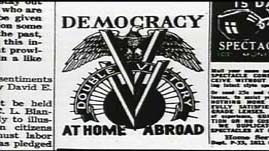Teachers' Domain - Digital Media for the Classroom and Professional Development
User: Preview

Source: The Black Press: Soldiers Without Swords


Funding for the VITAL/Ready to Teach collection was secured through the United States Department of Education under the Ready to Teach Program.
The following Frame, Focus and Follow-up suggestions are best suited for middle school students using this video in an English language arts or social studies lesson. Be sure to modify the questions to meet your students' instructional needs.
What is Frame, Focus and Follow-up?
Frame (ELA) What do you know about Jim Crow? Was Jim Crow a historical figure, or is it a name that refers to segregation? Does the name have more than one interpretation?
Focus (ELA) While watching the video segment, identify images that portray segregation. Identify images that portray patriotism.
Follow Up (ELA) Sometimes a single text can have multiple meanings, as in the case of Jim Crow or the Double V campaign. Can you think of other examples when a single text has multiple or dual meanings?
Frame (SS) What do you know about Jim Crow segregation? How did it come about? When did it end?
Focus (SS) Describe the Double V campaign. What do you think of the campaign’s purpose?
Follow Up (SS) When the United States was at war, African Americans participated in the war effort as soldiers and civilians but were critical of the treatment they received at home as second class citizens. How was it possible for them to be supportive and critical at the same time and still be good citizens?
NARRATOR: United States entry into World War II led to an outpouring of American patriotism. Many whites in mainstreams newspapers were zealous cheerleaders, but for black Americans enthusiasm for the war effort was often tempered by the bitter reality of segregation.
NARRATOR: James Thompson, a cafeteria worker from Wichita, Kansas, suggested in a letter to The Pittsburgh Courier that African Americans use the war overseas to press for change in their own back yard.
JAMES THOMSPON (VOICEOVER): “Should I sacrifice my life to live half- American? Will things be better for the next generation in the peace to follow? Let me colored Americans adopt the Double V for the double victory. The first V for victory over our enemies from without. The second V for victory over our enemies from within.”
EDNA CHAPPELL MCKENZIE: When this young fella, Thompson, came up with the idea of the Double V, Victory at Home and Victory Abroad, it fit right into all that we lived for.
VERNON JARRETT: Victory in Europe and in the Pacific, victory in Alabama, Mississippi, Georgia, Chicago, and Harlem and Detroit, as well, meaning a victory against racism.
ROBERT R. LAVELLE: And so The Courier came out with this Double V campaign and, of course, it spread—oh, we—we embraced it, hugged it, loved it, yeah. Agreed. That’s right. That’s what we did.
NARRATOR: The Courier received thousands of letters and telegrams and supported James Thompson’s idea. To capitalize on its readers’ sentiments, the ever-pragmatic Courier stepped up the Double V campaign.
PATRICK WASHBURN: The Pittsburgh Courier had a neat diagram, which was this Double V with an eagle in the middle, and people loved this kind of diagram. And you had women walking around with Double Vs on their dresses. You had a new hairstyle called the “doubler” where black women would walk around and weave two—two Vs in their hair. You had Double V baseball games, Double V flag-waving ceremonies, Double V gardens. I mean it’s just Double V this, Double V this, Double V this. And The Pittsburgh Courier, which was looking for circulation, played this to the hilt. There was even a Double V SONG.
“Every time I see a dusky soldier man with that rhythm in his step and gettin’ a tan, I could build a monument up in the sky and on it I would carve these words that cry. I’m a Yankee Doodle Dan, a Yankee Doodle Dan, where nothing can become the... “
EDNA CHAPPELL MCKENZIE: We were in war and in war you don’t have friendly relationship. You’re out to kill each other. And so that’s the way it was with The Courier. We were trying to kill Jim Crow and racism.
 Loading Standards
Loading Standards